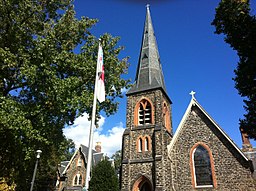The Baltimore Sun has a story on church closings and consolidations in several denominations including the Episcopal Church. The Rev. Daniel Webster, canon for evangelism and media for the Episcopal Diocese of Maryland, is quoted.
Webster says, it’s impossible to ignore the repeal of most of the old state blue laws, regulations that had long placed restrictions on commercial activity on Sundays, starting in the mid-20th Century.
Today’s faith leaders must compete with everything from youth soccer and pro football games to shopping at the mall.
“When I was growing up in what I call the salad days of the 1950s and early 1960s, the question in the neighborhood was ‘What church do you go to?’” Webster says.
“Now it’s, ‘Why do you go to church?’”
“We no longer live in Christendom. We really have to accept that it’s a thing of the past.”
What to do about it? Churches are reaching the point where the answer is close or consolidate.
With diocesan membership numbers in decline over the past half-century, the [Episcopal Diocese of Maryland] has closed a net 34 churches from its mid-1960s peak and merged five more, leaving a total of about 100.
…
Until the arrival of a new pastor last year, Saint John’s in the Village, founded in 1843, was slower to change.
The congregation, which employs a paid choir and practices an unusually formal high Anglican liturgy, spends a sizable portion of its $300,000 budget on maintaining its 159-year-old English Gothic church building.
When a major donor died, it became clear to the incoming priest-in-charge, the Rev. Jeffrey Hual, that other forms of stewardship had badly declined in the congregation. The diocese concluded that shrinking outreach into the community had led to a membership slide.
In his 14 months at the helm, Hual has helped raise more than $220,000, added 18 new members and increased neighborhood efforts, but his efforts may have come too late.
When Sutton met with church leaders in September, he gave them until early November to present him with a feasible financial plan or accept closure.
The deadline has since been extended to January.
Jon Gruber (the economist who was the architect the Massachusetts health insurance law, a pre-cursor to the ACA) and Daniel Hungerman studied the cost of blue laws.
Repealing America’s blue laws not only decreased church attendance, donations and spending, but it also led to a rise in alcohol and drug use among people who had been religious.

